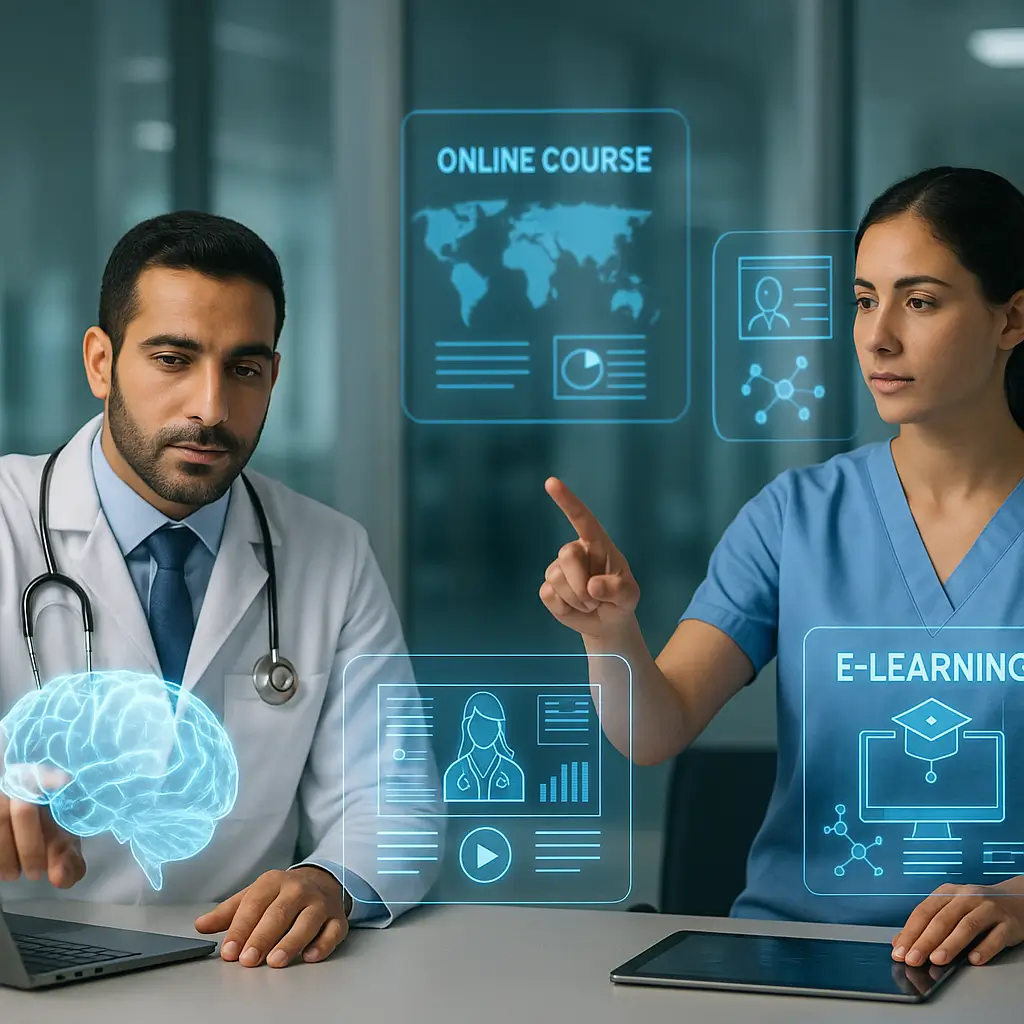Back to Blog
Medical Education
Featured
Virtual Reality in Medical Education: Immersive Learning Experiences
Exploring the revolutionary impact of VR technology on medical training and its potential to enhance clinical skills development.
.webp)
Virtual Reality in Medical Education: Immersive Learning Experiences
Exploring the revolutionary impact of VR technology on medical training and its potential to enhance clinical skills development, patient safety, and educational accessibility.
The VR Revolution in Medical Education
Virtual Reality is transforming medical education by creating immersive, risk-free learning environments where healthcare professionals can practice complex procedures, explore anatomical structures, and develop clinical skills without patient safety concerns.
Core VR Applications in Medical Training
Anatomical Visualization
3D anatomical models** for interactive exploration Layered visualization** of body systems and structures Microscopic detail** examination and analysis Comparative anatomy** across different populations
Surgical Training Simulation
Procedural rehearsal** in realistic virtual environments Haptic feedback** for tactile learning experiences Error consequence** modeling without patient risk Skill progression** tracking and competency assessment
Patient Interaction Scenarios
Communication skills** development and practice Empathy building** through patient perspective experiences Cultural competency** training across diverse populations Difficult conversation** preparation and practice
Emergency Response Training
Crisis scenario** simulation and response practice Team coordination** training in high-stress situations Decision-making** under pressure development Protocol adherence** in emergency situations
Advantages of VR in Medical Education
Risk Elimination
Patient safety** preservation during training Repeated practice** without consequences Experimentation** with different approaches Learning from mistakes** in safe environments
Accessibility and Scalability
Geographic barriers** elimination for specialized training Cost reduction** for expensive medical equipment Standardized experiences** across all learners On-demand availability** for flexible learning schedules
Enhanced Engagement
Immersive experiences** that increase retention Interactive learning** vs. passive observation Gamification elements** that motivate progress Personalized pacing** adapted to individual needs
Implementation Frameworks
Technology Infrastructure
Hardware requirements** and selection criteria Software platform** evaluation and implementation Network capabilities** for smooth operation Maintenance protocols** and technical support
Curriculum Integration
Learning objective** alignment with VR experiences Assessment methods** for VR-based training Progression pathways** through VR modules Traditional method** integration and balance
Faculty Development
Instructor training** on VR technology usage Content creation** capabilities and tools Student support** strategies for VR learning Technical troubleshooting** and assistance
Specialized VR Applications
Surgical Specialties
Minimally invasive** procedure training Robotic surgery** simulation and practice Microsurgery** precision skill development Orthopedic procedure** planning and execution
Diagnostic Training
Radiology interpretation** with 3D imaging Pathology examination** in virtual environments Clinical reasoning** through case-based scenarios Pattern recognition** development and refinement
Therapeutic Interventions
Rehabilitation technique** training and practice Physical therapy** movement analysis Pain management** approach development Behavioral intervention** strategy practice
Assessment and Evaluation
Performance Metrics
Skill acquisition** measurement and tracking Knowledge retention** assessment over time Competency demonstration** in virtual environments Transfer to real-world** performance evaluation
Learning Analytics
Progress tracking** through VR learning modules Engagement measurement** and optimization Difficulty identification** and support provision Personalization** based on learning patterns
Validation Studies
Effectiveness comparison** with traditional methods Learning outcome** measurement and analysis Cost-benefit analysis** of VR implementation Long-term impact** assessment on clinical practice
Challenges and Solutions
Technical Limitations
Motion sickness** mitigation strategies Hardware costs** and accessibility barriers Software compatibility** and integration issues Content quality** standards and development
Educational Integration
Faculty resistance** to technology adoption Curriculum space** allocation for VR training Assessment standardization** across VR platforms Accreditation compliance** for VR-based education
Ethical Considerations
Patient consent** for virtual patient representations Data privacy** in VR learning environments Accessibility** for learners with disabilities Equity** in VR technology access
Future Innovations
Advanced Technologies
Artificial Intelligence** integration for adaptive learning Haptic technology** advancement for realistic touch Mixed Reality** combining virtual and real elements Cloud computing** for powerful VR experiences
Expanded Applications
Mental health** training and patient interaction Pharmaceutical research** and drug interaction modeling Public health** scenario planning and response Healthcare management** decision-making simulation
Global Accessibility
Mobile VR** platforms for resource-limited settings Multilingual content** for international education Low-bandwidth solutions** for developing regions Open-source platforms** for widespread adoption
Implementation Best Practices
Pilot Program Development
Small-scale testing** with selected learner groups Feedback collection** and rapid iteration Success metrics** definition and measurement Scalability planning** for broader implementation
Content Development
Medical accuracy** validation by experts User experience** optimization for learning Accessibility standards** compliance Regular updates** based on medical advances
Support Systems
Technical support** infrastructure development Faculty training** programs and resources Student orientation** and ongoing assistance Continuous improvement** processes and protocols
"Virtual Reality in medical education is not about replacing human interaction—it's about enhancing the learning experience while maintaining the essential human elements of compassion, empathy, and professional judgment."
Conclusion
Virtual Reality represents a transformative technology for medical education, offering unprecedented opportunities for immersive learning, skill development, and patient safety enhancement. Success requires thoughtful implementation, strong support systems, and integration with traditional educational methods to create comprehensive learning experiences that prepare healthcare professionals for the complexities of modern medical practice.









.jpg)